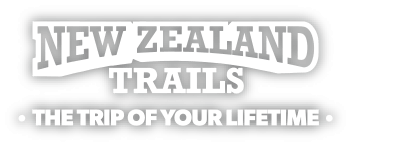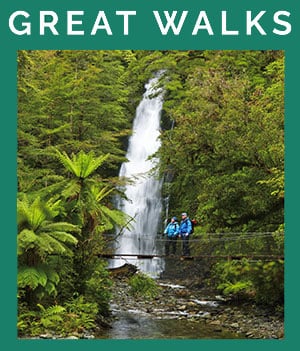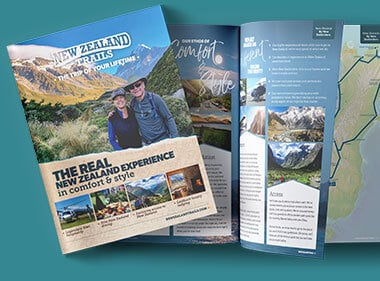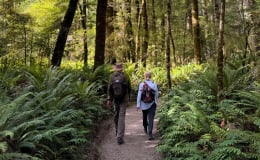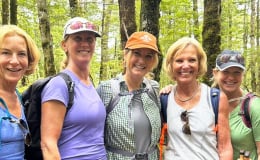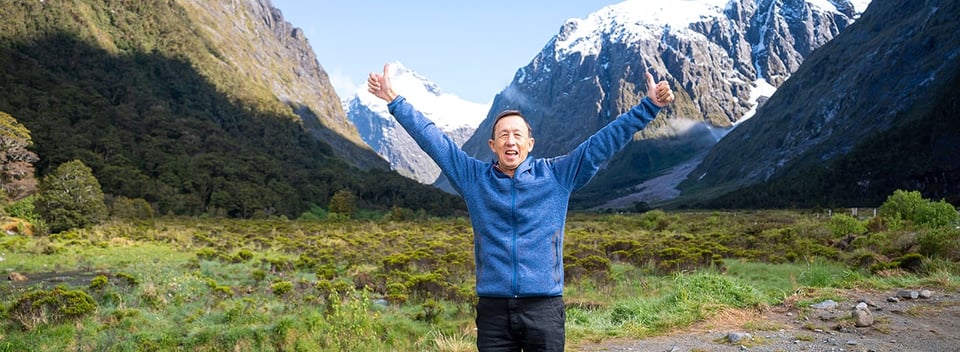
Hiking the Milford Track in New Zealand

Heralded in 1908 by poet Blanche Baughan as the ‘finest walk in the world’, Milford Track in New Zealand has captivated the hearts and minds of hikers from around the globe for well over 100 years now. And not without good reason has the world-renowned Milford Track stood the test of time, earning its place on many hikers’ bucket lists.
With two decades of experience sharing the Milford Track with our guests on our all-inclusive New Zealand hiking tours, we're here to share our local knowledge so you can make the most of this incredible track.
The history of New Zealand’s Milford Track
Originally utilised by the early Maori as a means of collecting and transporting precious pounamu (greenstone), the area is as rich with legend and history as it is native flora and fauna. In the late 1800s, early European explorers Donald Sutherland, John Mackay, Quintin Mackinnon and Ernest Mitchell all had a share in forming the track, providing access for more to enjoy.
Their achievements have been recognised by the naming of various geographical features in their honour. From the stunning Sutherland Falls to the heart-pumping Mackinnon Pass, the echoes of their pioneering footsteps are palpable with each passing kilometre.

The natural beauty of Milford and the surrounding area is nothing short of breathtaking.
Whilst the track itself has changed slightly over the past 100 years or so, the incredible landscape that it traverses remains as beautiful and wild as it ever was. Situated in the stunning Fiordland National Park at the bottom of New Zealand’s South Island, the Milford Track is an incredible four-day hike that will impress even the most well-travelled walker.
With the alluring prospect of Milford Sound/Piopiotahi waiting at the end of the hike, walkers are spurred on towards their destination, through thick forest, over mountain passes and past torrential waterfalls cascading just off the track.
Your Milford Track walking and hiking experience
As reluctant as we are to use a cliché, the Milford Track hike really is a once-in-a-lifetime experience, and one that you’ll be sharing with the grandchildren in years to come, perhaps as they pack their bags in preparation for their own journey to New Zealand. Before you can create your own Milford Track memories though, you might have some questions about the nitty-gritty details when it comes to the track itself. If you've stubbled across this post because you're keen on hiking in New Zealand but aren't quite sure where to start check out our handy guide to hiking in New Zealand first.
In readiness, we’ve put together some handy tips to help you enjoy your Milford Track hike, including an overview of the track, how to get there, the differences between a New Zealand Milford track guided walk and an independent hike, some day-hike options if you’re short on time or want to explore a bit further, information on the weather and what sort of flora and fauna you’ll find on the track. Read on and get set for your own journey on the Milford Track!
How long is the Milford Track?
Perhaps the most famous of New Zealand’s 10 Great Walks, the Milford Track is some 53.5km (33.2 miles) in length, taking you from Glade Wharf at the head of Lake Te Anau to Sandfly Point at Milford Sound. It follows the Clinton Valley to the Mackinnon Pass, which you then walk up and over to descend into the Arthur Valley, leading to Milford Sound.
Where is the Milford Track in New Zealand?
The Milford Track is located in New Zealand’s vast Fiordland National Park, an area often referred to as the ‘walking capital of the world’. Neighbouring hikes include the Routeburn, Hollyford and Kepler Tracks. As the glittering jewel in Fiordland’s hiking crown, however, the Milford Track is the one many gravitate towards.

How long does it take to walk the Milford Track?
The track can only be walked one way, and over the course of four days, you’ll discover shifting scenery and incredible views as you hike up mountains and down valleys, making your way closer to the Tasman Sea and the awe-inspiring Milford Sound. The trail is well marked and signposted and for the most part, wide and smooth, however, some sections are steep and rough, so you’ll need good footwear with solid ankle support.
As with a few other Great Walks, the Milford Track has a recommended hiking season between October and April each year (our spring through autumn). Outside of those months the track isn’t maintained or manned by rangers, and you’ll likely encounter hazards such as ice, snow, avalanches and flooding, quite easily turn your Milford Track hike into a Milford Track trek.
The Department of Conservation strongly recommends that you do not attempt the hike outside of the Great Walks season and we’re inclined to agree with them! Luckily you still have a good five months in which to take the hike and weather-wise, that’s certainly the best time of year to be out and about.
The Milford Track walking and hiking experience (explained)
Day 1: On day one of the hike you’ll travel by boat from Te Anau Downs to the head of Lake Te Anau and the track start point. The boat ride is an exciting way to kick things off as you speed across the deep waters of the South Island’s largest lake, travelling further into the heart of the Fiordland wilderness and catching glimpses of mysterious-looking inlets and hidden coves passing by. Once the boat docks at Glade Wharf, make time for a photo stop at the iconic Milford Track sign before lacing up your boots a little tighter and hitting the trail.
The first day’s hike is a relatively easy start as you make your way through the lush forest along the banks of the emerald Clinton River. An abundance of native flora and fauna greets you, with tree ferns festooning the track and friendly South Island robins watching curiously from low-hanging branches. Be sure to keep your camera handy to capture their antics!
Day 2: Day two takes you on a steady climb up to the source of the Clinton River at Lake Mintaro, a clear and cool body of water sitting at the base of the Mackinnon Pass towering above you. You may be tempted to take a dip in its icy waters depending on how much of a sweat you’ve worked up so far. Hiking through the Clinton Valley and past the Hirere Falls, you’ll get your first view of the incredible Pompolona ice field in the distance, a truly impressive sight.
Day 3: Day three takes you up and over the Mackinnon Pass, affording arguably the best views of the whole hike. Some 1154 metres (3786ft) up, you’ll enjoy a panorama across the surrounding mountains, valleys, forest and lakes. Take a moment to appreciate the view and catch your breath at the memorial to explorer Quintin McKinnon, early pioneer and namesake of the pass. You’ll then hike back down to the valley, encountering several thundering waterfalls along the way, including the dramatic Sutherland Falls, cascading some 580 metres (1904ft), making it one of New Zealand’s highest waterfalls.
Day 4: On the fourth and final day of the hike you’ll follow the flowing waters of the Arthur River to the historic boatshed shelter (an excellent place for morning tea if you’re wondering!). Crossing swing bridges and meandering along the trail, you’ll come across the torrential Giant Gate Falls, beautiful Mackay Falls and fascinating Bell Rock, a huge boulder hollowed out and flipped over by the powerful torrent of water over the years.

Experience the torrential Giant Gate falls in all its glory on your final day.
As you approach the end of the track at Sandfly Point, you’ll feel a sense of excitement building with your goal just a stone’s throw away. After a short but stunning boat ride into the fiord, you’ve made it! And what a way to finish your hike – rest up with a cold beverage at the pub and soak in the superlative views across the ‘eighth wonder of the world’, the stunning Milford Sound.
And of course, no hike would be complete without a cruise on the waters of the fiord afterwards. Board a vessel and sail the length of the fiord out to the surging Tasman Sea, marvelling at the granite cliffs rising sharply from the deep as hundreds of waterfalls cascade down the face to the waters below.
Over four days of hiking, those are just a handful of the highlights along the way, and without question, you’ll discover your own set of unique vistas and memories to take home with you. Be sure to pack your camera and spare batteries, you’ll be needing them!
Where is the Milford Track and how do I get there?
The Milford Track is in Fiordland National Park, which is part of the Southwest New Zealand World Heritage area on the South Island. By far the largest of our National Parks, it spans some 12,607 square kilometres (4,868 sq. mi) of remote but beautiful New Zealand wilderness. Whilst the track itself is in a somewhat secluded area, there’s easy access to both the start and end.
The best airport to fly into for access to the track is Queenstown, and on a clear day (which we, fortunately, have lots of), the flight into Queenstown is truly spectacular as you soar over the surrounding snow-capped mountains, offering a glimpse of the scenery to come. Queenstown International Airport is well served by both domestic air services and also international flights from Australia, so no matter where you’re travelling from, connections are relatively simple.
If you’re heading over from North America or Europe, you’ll fly into Auckland on the North Island and connect to a domestic flight to Queenstown, with a flight time of just under two hours. From Australia, fly into Christchurch on the South Island, and take an easy connecting flight to Queenstown which will have you there in about 45 minutes. Alternatively, there are direct flights from the East Coast of Australia.
Trails’ tip
Check out our guide on how to get to New Zealand to help you find which flights work best for you.
How do you get to the Milford Track?
When you’re planning your trip, we recommend spending some time in Queenstown before you begin the hike. Just over two hours from the start of the track at Te Anau Downs, this stunning mountain resort town is the perfect place to sample local cuisine in one of the many world-class restaurants, get your heart pumping with a myriad of adrenaline-fuelled activities, or simply enjoy a touch of luxury before heading out into the wilderness for a few days.

Explore Queenstown and its beautiful surroundings.
There are plenty of outdoor shops if you need to pick up any last-minute supplies (an extra pair of merino socks is always handy) and there’s also a DOC (Department of Conservation) office which provides New Zealand Milford Track maps, weather advice and track condition updates.
On the day of your hike, you can travel from Queenstown to Te Anau, but you’ll need to factor in the two hour drive time. Even though your first day on the track isn’t a long one, you may want to consider heading down to Te Anau the day before, so you’re not pressed for time.
The small town of Te Anau forms the gateway to Fiordland National Park and you’ll meet plenty of fellow hikers either about to head out on or have just finished one of the many incredible tracks in the area. You'll notice there’s a real sense of adventure in this lovely lakeside town, so we reckon it’s worth spending the night and soaking up the atmosphere.
To get to the Milford Track you’ll need to make your way along the lake to the wharf at Te Anau Downs, which is a 30-minute drive from the town. There are buses that run from Te Anau which you’ll need to pre-book, along with your boat ticket. There are two boats a day, departing from Te Anau Downs at 10.30am and 1pm, with the one-way trip taking just over an hour. If you’re driving yourself, be sure to arrive in good time as the boat won’t wait for anyone.
During the boat ride, enjoy a complimentary tea or coffee and learn a little of the history of the track and lake from your friendly local skipper. Once the boat docks at Glade Wharf, you’ll be asked to wash the soles of your boots to limit the spread of freshwater pests and diseases, which essentially means a quick splosh through a shallow bucket of solution to remove debris.
And then it’s time to get going on the track itself. It’s by no means a race, so don’t feel compelled to keep up with the hikers that charge ahead (unless that’s your thing of course), just walk at your own pace and revel in the fact that you’re walking the world-famous Milford Track!
Getting off the track
On the fourth and final day of the hike, you’ll finish up at Sandfly Point, the Milford Track trailhead. Aptly named, Maori legend has it that the gods who created Milford Sound feared that it was too beautiful, and humans would never want to leave, so provided a deterrent in the form of nasty biting sandflies.
Trails’ tip
Despite leaving a very itchy bite, sand flies are not poisonous, so you don’t need to worry if you do get nibbled a little. Covering up and liberally applying a good sandfly spray should keep them away.
Once you arrive at Sandfly Point, there’s a shelter to rest up and wait for the boat that will take you to the main Milford wharf. It’s a 15-minute boat ride and you’ll probably enjoy the chance to sit down and relax! The classic ‘Anita Bay’ launch has the job of transferring hikers from the track back to Milford, something it’s been doing for over 80 years! The first launch of the day for track walkers is at 2pm, followed by departures at 3pm and 4pm. They know exactly how many people are on the track and won’t leave anyone behind.
Many people opt to head straight back to Te Anau or Queenstown after completing the hike, but if you have time, then jump on board a late afternoon cruise of Milford Sound and reap the rewards of all your hard work. If you’re not so pressed for time, then spend the night in Milford Sound, either at Milford Sound Lodge or on board a purpose-built vessel. It’s a superlative way to experience Milford Sound and top off your hike!

Cruising Milford Sound is an incredible way to spend a day.
New Zealand Milford Track guided walk v. independent walks
Walking the Milford Track is a lifelong dream for many New Zealanders and overseas visitors alike and there are a few different ways to achieve it. You can either join a New Zealand hiking tour like the ones we offer, with everything taken care of for you, or you can opt to hike the track independently, which requires a lot more planning and preparation on your part. Either way, everyone starts at Te Anau and hikes through to Milford Sound, spending four days and three nights on the track and enjoying the same scenery along the way.
Independent hiking on the Milford Track
Independent (or ‘freedom’) walkers will hike the Milford Track without a guide and will need to book well in advance, prepare adequately and carry their own gear for the duration of the hike. If you’re thinking of going it alone, or with a hiking partner, then the best place to start your preparation is by contacting DOC who manage all independent track New Zealand Milford Track bookings. You can book a Milford Track package that includes your boat transfers on and off the track at each end, as well as your overnight accommodation in the huts on the track.
It’s worth noting that this package does not include the bus to Te Anau Downs (where the boat departs from) or from Milford Sound at the end of your hike. There are companies that can help you with transport to get you to and from each end of the track for an additional cost.
Trails’ tip
When planning your independent hike, keep in mind that spots are limited and fill up very quickly during the Great Walks season, with people often booking New Zealand’s Milford Track a year or more in advance.
During your three nights on the track, you will sleep in DOC huts, which are backcountry shelters built for hikers to spend the night. Camping is not permitted on the Milford Track, so the hut is your only option. There are three DOC huts on the Milford Track which you’ll hike between each day – Clinton Hut on night one, Mintaro Hut on night two and Dumpling Hut on night three. The huts have a warden who will collect your tickets (proving that you’ve booked and paid for your bunk) and keep you updated on weather and track conditions for the following day.
The huts sleep up to 40 people in large bunk rooms and have communal kitchens (gas cookers provided) with plenty of space for everyone. Mattresses are provided and there’s a coal burner in the common room, but no heating in the bunk rooms, so make sure your sleeping bag will pass muster.
There’s generator electricity for lighting only, which is handy for making dinner as well as a spirited game of cards in the evening. The lighting is switched off overnight, so you’ll need to bring a headtorch for brushing your teeth or overnight toilet visits. It’s also worth mentioning that there are no showers, flush toilets (long-drops are the order of the day out here) or drying facilities.
What to bring on your Milford Track hike?
You won’t be able to buy food along the track, so you’ll need to bring all your own supplies, including breakfast, lunch, dinner and high energy snacks, considering that you’ll probably be a little hungrier than usual with all that hiking! There’s plenty of water on the track, drinkable from side streams, but also from tanks at the DOC huts along the way. You’ll need to carry a good-sized water bottle (one to two-litre capacity) and make sure you stay well hydrated throughout your journey.

As well as your sleeping bag, you’ll also need to bring your own eating and cooking utensils, plus a first aid kit, survival kit and whatever clothing and toiletries you require. Make sure you have a comfortable backpack to lug all your gear (40-60 litre size) and a waterproof pack liner in case of inclement weather. You can get a comprehensive packing list from DOC to ensure that you have everything you need for a safe and enjoyable independent hiking experience.
Trails’ tip
Quick-dry fabric clothing is essential when hiking the Milford Track. Whether you’ve been caught in a downpour, or you’ve worked up a bit of sweat, it’s nice to be able to put on dry (albeit slightly smelly) clothes the next day. Look out for breathable fabrics that wick moisture away from your skin like New Zealand merino wool. Here’s what we recommend you pack for your New Zealand hiking trip.
New Zealand’s Milford Track guided walks and hikes
A Milford Track guided hike is a more luxurious option and there are several companies that offer this experience. Pick up options from either Queenstown or Te Anau are available and from start to finish, you’ll be looked after. All you need to do is choose a company, pay the trip fare and they’ll take care of the rest. No need to worry about transport, Milford Track hut bookings or even what you’re going to eat while you’re hiking! Guided group sizes on the Milford Track can be up to 50 people with three or four guides, so if you prefer small-group travel then that’s something to think about.
Instead of staying in the DOC huts, guided hikers stay in privately owned and operated lodges along the way. The lodges, Glade House on night one, Pompolona Lodge on night two and Quintin Lodge on night three, are generally about two hours before the independent huts, meaning you’ll have a much shorter walk on day one, but a longer hike on the last day. (You won’t need to make Milford Track bookings)

Offering all the comforts of home in the middle of nowhere, these lodges are very well run and have everything a walker could want, including hot showers, a drying room, tasty meals and a well-stocked bar! There is a range of rooms available, from bunk rooms with shared facilities to private rooms with ensuite bathrooms, depending on what your budget is. Breakfast, lunch and dinner are prepared for you, and snacks such as scroggin, fruit and chocolate are also provided. You certainly won’t go hungry.
All your bedding, towels and even shampoo and soap are included, so all you need to carry are the essentials like your camera, rain jacket, lunch and a change of clothes for the evening. They can even lend you a backpack if you don’t have one of your own. It’s a great option if you like the idea of hiking, but don’t want to carry too much while you walk, or don’t want to bring much more than your hiking boots with you on the plane.
As the groups can be quite large, the guides only have a limited amount of time to spend with individual walkers, but they will get around and tell you a bit about the track and the incredible environment you’re exploring. As you hike, there are well-spaced shelters along the way to rest up and have lunch or a snack, and your guides will even make you a hot drink to enjoy.
One huge bonus about doing the track guided is that you get to spend your last night in Milford Sound, which is a wonderful way to round off your walk with all your new friends. A cruise on the fiord the next day is included in the trip fare before you hop on the bus and head back to either Te Anau or Queenstown.
Trails’ tip
Everyone will have a different budget in mind, but if the comforts of home are important to you, then the guided walk is well worth it. It makes a big difference when you can have a hot shower at the end of the day and enjoy a delicious meal that you don’t have to cook, then hop into a clean bed with freshly laundered sheets. The next day of hiking feels very manageable with that to look forward to at the end of it!
Main differences between independent and guided hiking
What are the main differences between Milford Track guided walks and independent hikes?
- Preparation: If you’re hiking independently there’s a lot to organise in advance including your clothing, food, cooking gear, safety equipment and sleeping bag, as well as booking your transport and DOC huts. If you’re on a guided trip, you’ll only need to organise your clothes and personal items, as everything else is taken care of.
- How much you carry: It’s easy to tell who’s walking independently and who are walking as part of a guided group by how much they’re carrying on their backs. Independent walkers will be laden down with a heavy pack, although the good news is it will get a little lighter as you eat your supplies along the way!
- Guides: A guided walk means just that – you’ll be accompanied by well-trained and knowledgeable guides who will be able to offer support and advice along the way, anything from giving you a bit of a pep talk to identifying the native flora and fauna on the track. Going it alone means you’ll be self-reliant the entire way, but you’ll run into plenty of other friendly walkers and a real sense of camaraderie builds over the four days.
- Safety: Regardless of whether you’re walking as part of a group or independently, DOC is very careful about the safety of all walkers. In the event of extreme weather, everyone is looked after by DOC staff and track guides. Guided hikes are only available during the Great Walks season. You can walk the track independently year-round, however, DOC strongly recommends that you do not attempt it unless you are very experienced in the New Zealand backcountry and have navigation, river crossing and alpine skills.
- Your fellow hikers: It’s fair to say that the average age of the guided hikers is a bit higher than those hiking independently. Despite that, we’ve seen people from 13 to 80 on the guided hike, and equally there are some very sprightly silver headed hikers carrying their own packs on an independent hike too!
- Cost: With all the bells and whistles provided, it makes sense that a guided hike is going to cost significantly more than going it alone. To give you a comparison, the five days/four night guided hike starts at around NZ$2,130, moving up in price depending on what type of room you’d like. To walk the track independently from Queenstown over four days/three nights will cost you around NZ$500 for all your accommodation and transport. Remember, food will be an additional cost to factor in.
Whether you’re hiking independently, or you opt to join a guided walk, the Milford Track is an incredible experience. You certainly won’t regret your time on the trail, and you’ll look back fondly on the memories created and new friends made.
Day walks on the Milford Track
What if you don’t have time to walk the full length of the track, or you just want to hike a section of it, rather than the entire 53.5 kilometres? Fear not, we’ve got you covered! The South Island and the World Heritage Fiordland region has so much to offer that it would be criminal not to explore much beyond the Milford Track, so we reckon that if you’re short on time or want to experience more of this incredible part of the country, then a day hike on the Milford Track might be just what you’re looking for. Here are two great options to consider.

How about some inspiring sights? Our guides take you to the best spots.
Milford Track day walk from Sandfly Point, Milford Sound
This fantastic hike is a real treat and perfect for people who want to experience both the Milford Track and Milford Sound on the same day. In effect, you’ll be hiking the last section of the track in reverse by hopping on the boat at the main Milford Wharf and then cruising across the deep waters of the fiord to Sandfly Point, where you’ll disembark to begin your walk on the track itself. It’s a short boat ride, but the views of Milford Sound are breath-taking! There’s no public boat to Sandfly Point, so the only way to experience this end of the track and the Sound on the same day is to join a guided tour. There are day tours departing at around 8am.

Don't miss a single detail - see the Sound by boat, too!
It’s around an 8km (5 miles) return hike from Sandfly Point and will give you a great taste of the Milford Track, including the unique flora and fauna of the area. You’ll follow the track to Giant Gate Falls, an impressive plunge waterfall cascading 30 metres (98ft) into a clear green-blue pool at the base. You’ll be able to capture some beautiful photographs from the bridge that spans the pool, but be sure to spend a moment simply appreciating where you are and take some mental snapshots as well. The walk is doable in half a day, with time for a morning tea break, of course, leaving you the rest of the day to cruise the length of the Sound.
Milford Track day walk from Glade Wharf to Clinton Forks
This day hike is a great way to experience the Milford Track and Lake Te Anau in the same day and the timings work well for a day trip from Te Anau or Queenstown. You’ll also get a real buzz from the other hikers about to embark on their four-day adventure on the track. Get yourself to Te Anau Downs for the 10.30am boat and you’ll arrive at Glade Wharf and the start of the Milford Track at approximately 11.45am.
With about five hours up your sleeve before the boat departs again from Glade Wharf, you’re free to take a leisurely stroll on the first section of the track that follows the tranquil waters of the Clinton River. It’s a smooth, flat trail that will take you past the historic Glade House, across swing bridges and through the thick rainforest.
It’s a 5km (3.1 miles) walk to the Clinton Hut, which is the DOC hut where independent hikers spend their first night. It’ll take around 1.5 hours to get there and it’s a good place for lunch before you retrace your steps back to the boat, which departs the wharf where you originally disembarked.
There are a couple of fantastic side trips that are worth the effort if you have time – the Glade Burn, the Wetland Walk and the ‘Big Tree’ are memorable sights and often something that the multi-day hikers won’t get to see. You can do this day walk by yourself or join a guided tour from Te Anau or Queenstown.
What will I see on the Milford Track?
Milford Track’s flora and fauna
Traversing both lush rainforest and alpine passes, the flora and fauna you’ll encounter while hiking the trail are both diverse and beautiful. The unique environment encourages flourishing greenery and to date, there are over 700 plant species found only in Fiordland, contributing in no small way to the area’s World Heritage status.
Plantlife
Setting off through the quiet undergrowth, you’ll be surrounded by native southern beech forest, made up of different varieties including the silver beech, red beech and mountain beech. Emerging above the beech trees, you’ll also see ancient rimu trees growing up to 40 metres (131ft), as well the imposing kahikatea, or white pine, which can grow up to 60 metres (196ft) in lowland environments. The forest floor is spread with a rich blanket of mosses and lichens, while tree ferns, including the iconic silver fern, curl their way gracefully up to rays of sunlight that break through the thick canopy above.

Peer above the lush canopy - you're in for a treat!
Slightly higher up the mountain slopes, you’ll encounter the majestic totara tree, a strong wood that was used by the Maori to make waka (canoes) and create carvings. If you’re hiking between November and February, you’ll enjoy a special sight once you make your way above the treeline. As you climb higher up the Mackinnon Pass, you’ll be flanked by a beautiful display of alpine flowers including the Mount Cook buttercup, mountain daisy and the tiny gentian. Combining this pretty foreground with the impressive mountain ranges in the background makes for a very lovely vista indeed.
Milford Track’s Wildlife
The forests of Fiordland are alive with the song of native birds warbling in the treetops and during your hike on the Milford Track, you’re likely to encounter many of its avian inhabitants. Listen out for tui and bellbirds calling to one another, while cumbersome wood pigeons flap noisily from branch to branch above you. The brilliant blue feathers and red beak of New Zealand’s swamp hen, or pukeko should be easy to spot in the undergrowth too.

You may see a distinctive Tui on your travels; if you're lucky you'll get to hear one sing, too.
Due to much hard work in the field of conservation, endangered species such as the whio, or blue duck, are also making a comeback. Ongoing efforts are being made to ensure that vulnerable species are protected, and this incredible environment is preserved for future generations, both animal and human.
Once you make it to Milford Sound, a host of marine life will often be waiting for you, including New Zealand fur seals and the rare Fiordland crested penguin. Very occasionally migrating whales will also put in an appearance, although you’re far more likely to be joined by playful pods of dusky and bottlenose dolphins on your cruise along the Sound.

Meet the locals! The seals of Milford Sound.
Whilst not native, this next beast is more of a Fiordland curiosity, so worth mentioning, just in case you do spot one! On your travels through the Milford wilderness, you may hear tales of the elusive ‘Fiordland moose’, New Zealand’s slightly more believable answer to the Yeti. Stories of moose sightings have been bandied about for decades after ten moose were first released in the area in 1910.
Due to their food supplies being consumed by introduced red deer, the moose were thought to have become extinct in the area by the 1950s. But rumours persist and there are still ‘moose chasers’ intent on proving their existence today. So, while you’re hiking the track, keep your camera poised and ready as visual proof will be required!
Mythical moose aside, the Milford Track is home to some truly rare and unique wildlife and if you’re a nature lover, you’ll relish the chance to witness them in their natural environment going about their business as though the hikers observing them were simply part of the landscape too.
What else is there to see and do in Fiordland?
Aside from the Milford Track and Milford Sound itself, there’s lots to see and do in and around the wider Fiordland area. Take the time to explore this region and discover your own hidden delights, as well as those we’ve already mentioned.
Te Anau
The picturesque lakeside town of Te Anau is alive with travelling hikers and hardy locals alike. There are lots of different places to stay and many restaurants and cafes offering hearty fare, strong coffee or a pint of something cold. There’s not much in the way of shops, but you can pick up the essentials as well as a pair of cosy possum fur liners for your shoes if you’d like!
It’s the closest town to Milford Sound, which is a scenic 2.5-hour drive away. Many travellers opt to base themselves in Te Anau for their time in Fiordland. Aside from hiking, other local attractions and offerings include lake cruises, seaplane flights, fishing tours, kayaking and exploring the Te Anau glow worm caves.
The Homer Tunnel
On the journey between Te Anau and Milford Sound, just before descending into the Cleddau Valley, you’ll pass through the Homer Tunnel – an incredible feat of engineering that stretches 1.2km (0.75 miles) through solid rock. The tunnel took 19 years to construct, and before it opened in 1954, there was no road access to Milford Sound.

If you think this is impressive, you should see the other direction!
At the entrance to the tunnel, you’ll often encounter New Zealand’s cheeky alpine parrot, the kea with its olive-green feathers and bright orange bursts under its wings. They’re fun to watch but have a peculiar taste for rubber, so drivers should mind out for the seals on their car doors and windows! When you pop out at the other end of the tunnel, the views are mind-blowing. We won’t spoil the surprise, but safe to say you’ll be impressed.
Great Walks
As well as the Milford Track, you’ll find two more of New Zealand’s Great Walks located in Fiordland – the Routeburn and the Kepler Tracks. The Routeburn Track covers 32km (20 miles) of stunning Fiordland backcountry, offering the ultimate alpine adventure. Made up of incredible mountain views, native forests and torrential waterfalls, it’s worth making the Routeburn Track a feature of your time in Fiordland.

The Routeburn is another "Great" option for a hike...
The Kepler Track covers some 60km (37.3 miles) of pristine Fiordland wilderness and, unlike many of our other hikes and walks, this track was purpose-built to make the most of the landscape. The entire length of the trail takes three to four days to hike, but there are day hike options available too.
Trails’ tip
In addition to exploring Milford Sound and travelling through the Homer Tunnel, our 14-day Masterpiece trip includes the chance to hike on both the Routeburn and Kepler Tracks, as well as spending time in Te Anau and Queenstown.
Queenstown
Not actually in Fiordland but well worth a visit, as we mentioned earlier Queenstown is a jewel in New Zealand’s tourism crown, a small town nestled on the shores of Lake Wakatipu. Famous for its high-octane adventures, as well as slower-paced outdoor activities, Queenstown is a good place to spend a day or two during your time in New Zealand. The surrounding area is home to many purpose-built tracks and trails that weave their way through the landscape, making a walk, run or bike the perfect way to sightsee.

Queenstown is one of the best locations in the world for bike riding.
Downtown offers a cosmopolitan blend of cafes, restaurants, spas and boutique shopping, so it’s the ideal place to relax before or after a hike in the wilderness. Queenstown is around a four-hour drive from Milford Sound, but the journey is an outstanding one and regularly voted as one of the best drives in the world!
What’s the weather on the Milford Track like?
Now we’ve covered all the nitty-gritty details of the Milford Track and the surrounding area, we come to the million-dollar question; what’s the weather like? Well, we’re glad you asked! New Zealand weather (in general) is very changeable and never more so than in Fiordland. It’s an amazing area of pristine rainforest and rugged peaks and it’s the natural elements that are largely responsible for this, so we’re not complaining about anything the weather throws at us.
Milford is famous for its ‘liquid sunshine’ and is officially the wettest place in New Zealand. With an astonishing average of 182 rain days a year, the volume of water certainly contributes to the beauty of the area, with native plant life flourishing and many hundreds of thundering waterfalls making their way down the imposing granite cliff faces. The wild weather makes for a very refreshing experience and chances are you’ll never feel more alive than when you’re standing at the base of a thundering waterfall breathing in the spray!
That’s not to say that you’ll never get good weather on the Milford Track; there is often plenty of blue skies and warm sunshine as you hike, particularly if you aim for the peak summer months between December and February.
Trails’ tip
Here at New Zealand Trails, we run our multi-day guided walking tours between October and April, which is spring through autumn in New Zealand. For more information on the best time to hike in New Zealand, check out this blog.
When it comes to hiking the Milford Track it pays to be prepared. In the words of the Department of Conservation, “plan for the worst, expect the best”, meaning it’ll probably rain, but you’ll still have an amazing time if you’re well prepared. Rain jackets, quick-dry clothing and solid, waterproof boots will be invaluable during your time on the track.
Be sure to check the weather forecast before you embark on your adventure and chat with DOC rangers at the huts throughout your hike for up-to-the-minute weather information. Conditions can change very quickly in Fiordland and unsuspecting hikers have been caught off guard. Don’t be one of them!
Explore the Milford Track for yourself
No matter which way you choose to experience the Milford Track, it will be an incredibly memorable experience. If you’re planning on going it alone, then be sure to prepare well and you’ll enjoy the adventure. If you’d rather experience a touch more luxury on your travels, then taking a guided hike could be the right option for you.
You can also request a free copy of our 36-page brochure for detailed information on all our multi-day guided tours. Happy hiking!
Other articles you may like:
- What’s the best time to walk the Milford Track?
- Routeburn and Milford Track – the best one-day hiking options
- The Great Walks of New Zealand
- Five reasons why Milford Sound is Best in the Rain
- Get your free New Zealand Trails guided tour brochure
